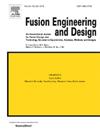中子辐照和非辐照条件下钨中氘泡演化的分子动力学模拟
IF 1.9
3区 工程技术
Q1 NUCLEAR SCIENCE & TECHNOLOGY
引用次数: 0
摘要
钨(W)是托卡马克核聚变反应堆的壁材料,会受到高能中子和高通量氘(D)等离子体的辐照。特别是在存在氘气泡的情况下,中子辐照会显著加剧材料机械性能的恶化。然而,很少有研究关注中子辐照对钨中氘气泡的影响,而且中子辐照下氘气泡演化的机理仍不清楚。在本研究中,我们利用分子动力学方法模拟了氘泡的演化过程,揭示了一个完整的演化过程:驻留、膨胀和破裂。此外,D气泡的原初敲击原子(PKA)辐照结果表明,高能中子通过碰撞级联将能量传递给气泡内的D原子,导致气泡内总压力骤增,从而促进了D气泡的演化。温度、D 原子与空位比(D/V)和 PKA 能量决定了钨中 D 气泡的行为。我们通过计算 D 气泡的状态,比较特定条件下 D 气泡内部压力和体积的变化,详细总结了这三个变量对 D 气泡演化的影响。我们观察到纯 W 表面在中子辐照下的改性过程,碰撞级联在 W 晶格内产生了 Frenkel 缺陷对。通过分析浓度变化,我们将弗伦克尔缺陷的演化过程分为三个阶段:生长、消除和稳定。本研究提出了一种可能的机制来解释中子辐照诱导的 PKA 级联刺激 D 气泡的演化,为改进和选择面向等离子体壁的最佳材料提供了重要的理论指导。本文章由计算机程序翻译,如有差异,请以英文原文为准。
Molecular dynamics simulations of deuterium bubble evolution in tungsten under neutron irradiation and non-irradiation conditions
Tungsten (W), the wall material in Tokamak fusion reactors, is subjected to irradiation from high-energy neutrons and high-flux deuterium (D) plasma. In particular, in the presence of deuterium bubbles, neutron irradiation can significantly exacerbate the deterioration of the mechanical properties of the material. However, few studies have focused on the effect of neutron irradiation on deuterium bubbles in tungsten, and the mechanism of deuterium bubble evolution under neutron irradiation remains unclear. In this study, we simulate the evolution of D bubbles using a molecular dynamics approach, revealing a complete evolutionary process: standing, expanding, and bursting. In addition, the results of primary knock-on atom (PKA) irradiation of D bubbles show that high-energy neutrons transfer energy to the D atoms inside the bubbles through collision cascades, leading to a surge in the total pressure inside the bubbles, which contributes to the evolution of the D bubbles. Temperature, D atom to vacancy ratio (D/V), and PKA energy determine the behavior of D bubbles in tungsten. The effects of these three variables on the evolution of D bubbles are summarized in detail by counting the states of the D bubbles and comparing the changes in pressure and volume inside the D bubbles under specific conditions. We observed a modification process by neutron irradiation on a pure W surface with collision cascades generating Frenkel defect pairs within the W lattice. By analyzing the concentration changes, the evolution of Frenkel defects is divided into three stages: growth, elimination, and stabilization. The present work proposes a possible mechanism to explain the evolution of D bubbles stimulated by PKA cascades induced by neutron irradiation, providing an important theoretical guideline for the improvement and selection of optimal materials oriented towards the plasma wall.
求助全文
通过发布文献求助,成功后即可免费获取论文全文。
去求助
来源期刊

Fusion Engineering and Design
工程技术-核科学技术
CiteScore
3.50
自引率
23.50%
发文量
275
审稿时长
3.8 months
期刊介绍:
The journal accepts papers about experiments (both plasma and technology), theory, models, methods, and designs in areas relating to technology, engineering, and applied science aspects of magnetic and inertial fusion energy. Specific areas of interest include: MFE and IFE design studies for experiments and reactors; fusion nuclear technologies and materials, including blankets and shields; analysis of reactor plasmas; plasma heating, fuelling, and vacuum systems; drivers, targets, and special technologies for IFE, controls and diagnostics; fuel cycle analysis and tritium reprocessing and handling; operations and remote maintenance of reactors; safety, decommissioning, and waste management; economic and environmental analysis of components and systems.
 求助内容:
求助内容: 应助结果提醒方式:
应助结果提醒方式:


